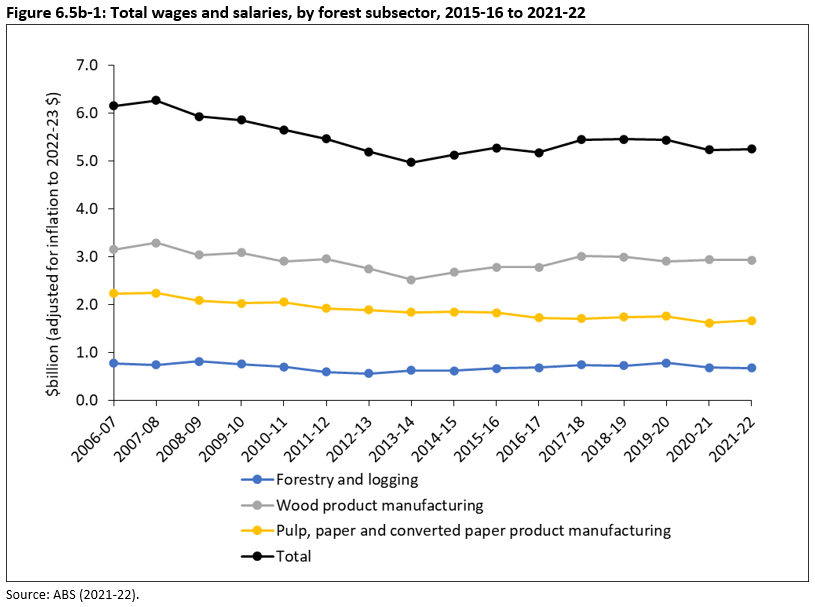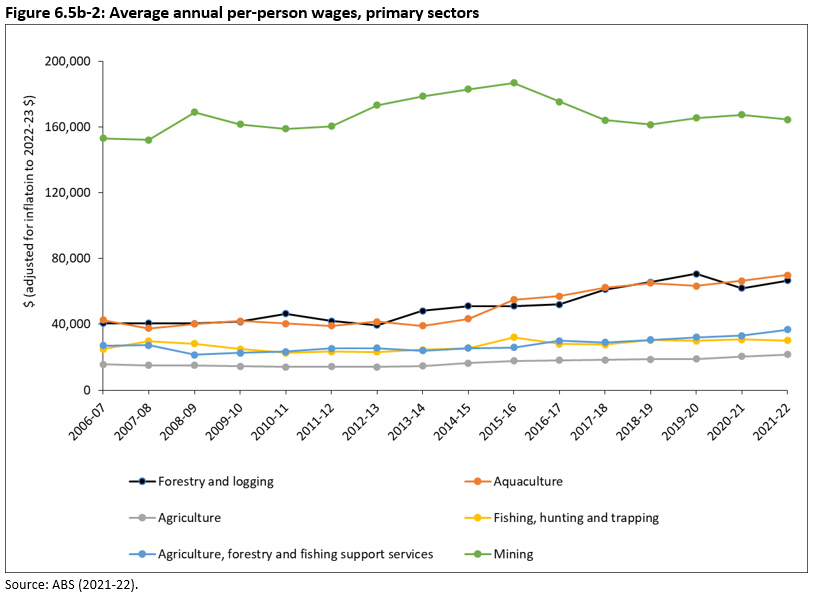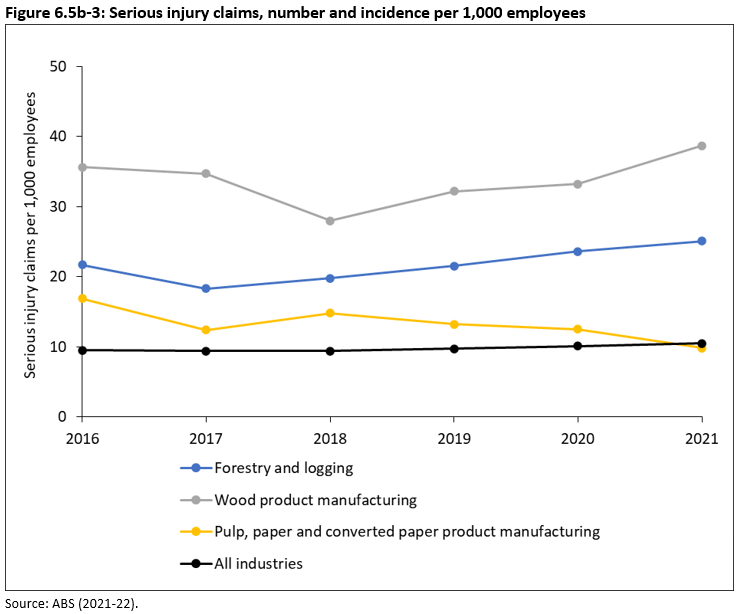This indicator measures the level of wage and injury rates in the forest sector. A sustainable industry will ensure high levels of workforce health with welfare and wage rates comparable with national averages for other occupations.
This is the Key information for Indicator 6.5b, published July 2024.
- Total annual wages and salaries in the forest sector between 2016–17 and 2020–21 remained relatively constant when adjusted for inflation.
- Between 2015–16 and 2020–21, serious injury claims in the forest sector increased slightly in total number and rate per 1,000 employees.
National data on wages and salaries are derived from the Australian Bureau of Statistics (ABS) Census of Population and Housing 2021. Between 2016-17 and 2020-21, total annual wages and salaries in the forest sector remained relatively constant, varying between a minimum of $5.18 billion in 2016-17 and a maximum of $5.46 billion in 2018-19 after adjusting for inflation (Figure 6.5b-1). From 2016-17 to 2020-21 total annual wages and salaries:
- stayed constant in the Forestry and logging subsector
- increased by 6% in the Wood product manufacturing subsector
- decreased by 6% in the Pulp, paper and converted paper product manufacturing subsector.
In 2020-21, total forest sector wages and salaries comprised:
- the Wood product manufacturing subsector (56%)
- the Pulp, paper and converted paper product manufacturing subsector (32%)
- the Forestry and logging subsector (13%).
The average per-person wage for the forestry sector increased slightly over the period 2016-17 to 2020-21 when adjusted for inflation, as part of a steady trend (Figure 6.5b-2). The forestry sector had a higher average annual growth rate in per-person wages (4.2%) than other primary and manufacturing sectors (the average annual growth rates for mining and manufacturing were -2.1% and -0.5%, respectively).
However, care must be taken when reviewing these figures as the change in total and average wages for a sector may be due to a combination of changes in:
- the total number of employees
- the proportion of employees that are part-time or full-time
- the average hours worked by part-time employees
- actual wage rates paid.
There is insufficient detail in statistics for the Australian forestry industry to determine the scale of influence of each of these possible factors, so caution must be used in interpreting the data presented here.
Wages and salaries for other types of employment, such as in forest-based tourism, or management of forested national parks and reserves, are not captured here.
Click here for a Microsoft Excel workbook of the data for Figure 6.5b-1.
Click here for a Microsoft Excel workbook of the data for Figure 6.5b-2.
National data on injury and fatality rates in the forest sector are sourced from Safe Work Australia.
Between 2015-16 and 2020-21, the number of serious injury claims:
- increased by 21% in the Forestry and logging subsector, from 126 to 152
- increased by 12% in the Wood product manufacturing subsector, from 1,252 to 1,406
- decreased by 12% in the Pulp, paper and converted paper product manufacturing subsector, from 205 to 181.
Between 2015-16 and 2020-21, the incidence of serious injury claims per 1,000 employees:
- increased in the Forestry and logging subsector, from 21.7 to 25.1
- increased in the Wood product manufacturing subsector, from 35.6 to 38.7
- decreased in the Pulp, paper and converted paper product manufacturing sector, from 16.9 to 9.8.
Incidence rates in 2020-21 for the Forestry and logging, and Wood product manufacturing subsectors were significantly higher than the all-industries average (Figure 6.5b-3). The Pulp, paper and converted paper product manufacturing subsector incident rates in 2020-21 were on par with the all-industries average.
Click here for a Microsoft Excel workbook of the data for Figure 6.5b-3.
Reported compensated fatalities between 2014-15 and 2020-21 comprised:
- 17 in the Forestry and logging subsector
- 10 in the Wood product manufacturing subsector
- 3 in the Pulp, paper and converted paper product manufacturing subsector.
Between 2014-15 and 2020-21, the average incidence of compensated fatalities per 1,000 employees was:
- 0.64 in the Forestry and logging subsector
- 0.06 in the Wood product manufacturing subsector
- 0.05 in the Pulp, paper and converted paper product manufacturing subsector.
Due to the small numbers of fatalities in any one year, individual year data are aggregated in the data source (Safe Work Australia 2012).
Further information
- Data sources
- Awards regulating employment conditions
- Forest industry subsectors



